
German postcard by Ross Verlag, no. 6242/1, 1931-1932. Photo: Metro-Goldwyn-Mayer. Grace Moore in A Lady’s Morals (Sidney Franklin, 1930).

Belgian postcard by P.I.A. Belgaphot, Bruxelles, no. 75. Photo: MGM.

Dutch postcard, no. 669.
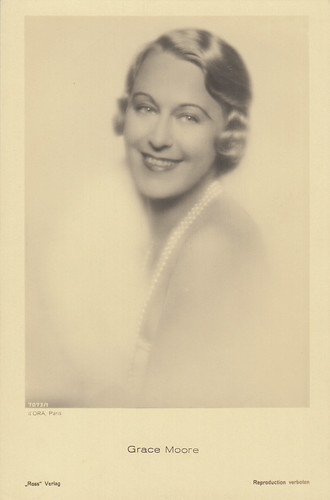
German postcard by Ross Verlag, no. 7073/1, 1931-1932. Photo: d'Ora, Paris.
From Slabtown to the Metropolitan Opera
Grace Moore was born& Mary Willie Grace Moore on the 5th of December 1898 in Slabtown, Tennessee, U.S.A.
At the end of the 10’s, she got voice training at the Wilson-Greene School of Music in Washington and, in 1919, she went to New York to start a stage career. In 1920, she appeared for the first time on Broadway in the musical 'Hitchy-Koo'.
She soon went to Paris, where she continued her musical training. When she got short of funds, she came back to the U.S.A. and successfully appeared on Broadway in 'The Music Box Revue' of 1923 (1923-1924) and 'The Music Box Revue of 1924' (1924-1925).
As her goal was to become an opera singer, she returned to Europe in 1925 for further classical study. After having been thoroughly prepared musically and linguistically for an operatic career, she made an impression on Giulio Gatti-Casazza, the Director of the Metropolitan Opera of New York, who signed her in mid-1927.
So, she went back to her native country and made her debut at the prestigious Metropolitan as Mimi in 'La Boheme' in February 1928. That same year, she played the same role at the Opera-Comique in Paris. In 1935, she would achieve great success by playing Mimi again at Covent Garden in London.
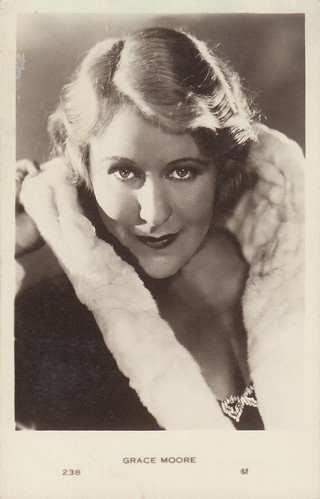
Spanish postcard by M.C. Barcelona, no. 238.
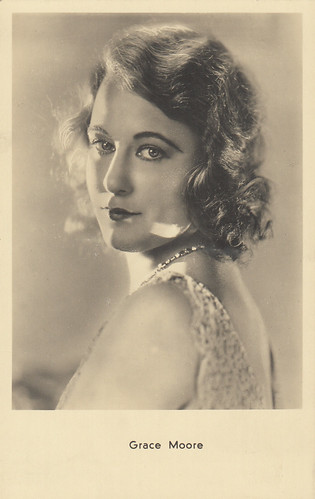
Austrian postcard by Iris Verlag, no. 6784.
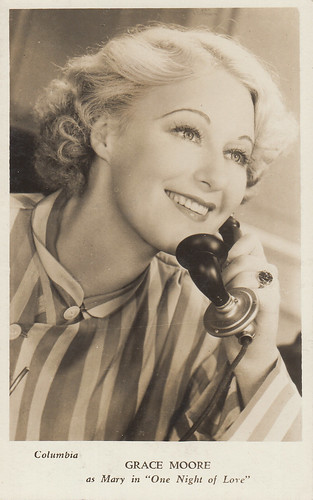
British postcard. Photo: Columbia. Grace Moore in One Night of Love (Victor Schertzinger, 1934).
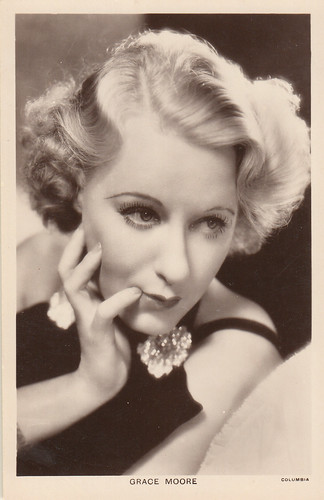
British postcard in the Picturegoer Series, no. 890. Photo: Columbia.
Hollywood
Under contract to M.G.M., Grace Moore made her screen debut in A Lady’s Morals (1930) and was also featured in its French-language version, Jenny Lind (1931). She then co-starred with Metropolitan tenor Lawrence Tibbett in New Moon (1930).
Unfortunately, A Lady’s Morals and New Moon didn’t fare especially well at the box office and M.G.M. dropped her. She had to wait a few years more until Hollywood beckoned again.
It happened when Harry Cohn, head of Columbia, noticed her on Broadway in the operetta 'The Dubarry' (1932-1933) and signed her. Her first film at Columbia, One Night of Love (1934), was a smash hit and eventually made her a full-fledged movie star. This movie gave movie audiences the opportunity to hear her sing several arias from famous operas such as 'Carmen', 'La Traviata' or 'Madame Butterfly'. It was followed by another success, Love Me Forever (1935).
In 1935, she was awarded a medal by the Society of Arts and Science for her achievement in raising the standard of cinema entertainment. Suddenly, opera became all the rage in Hollywood. Paramount signed Gladys Swarthout and R.K.O. signed Lily Pons. Even Poverty Row’s Republic Studios wanted their own diva and hired Marion Talley, who had been in 1926 the youngest prima donna to sing at the Metropolitan Opera at that time. None of them achieved the same success onscreen.
Grace Moore then played Elizabeth "Sissi" of Austria in The King Steps Out (1936), the only musical Josef von Sternberg ever directed. Her stay at Columbia ended with When You’re in Love (1937) and I’ll Take Romance (1937). In addition to her movie career, she also increased her popularity by performing on the radio.

Italian postcard by Ballerini & Fratini, Firenze, no. 2843.
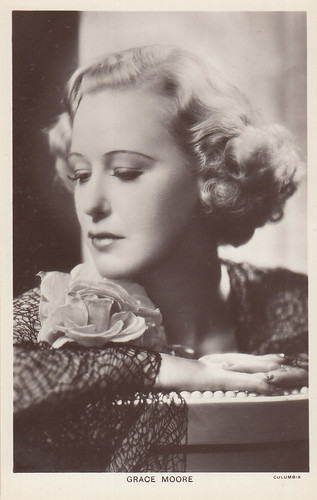
British postcard by Picturegoer, no. 890a. Photo: Columbia.
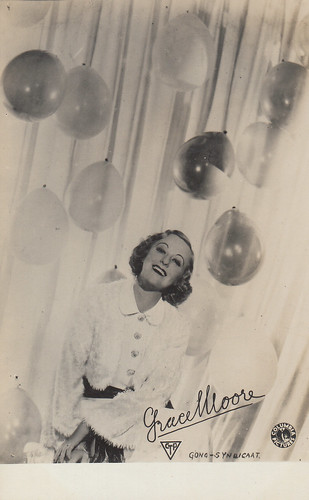
Postcard from the Dutch East Indies (now Indonesia) by CTP. Photo: Columbia Pictures.

Italian postcard by B.F.F. Edit., no. 7393. Grace Moore in The King Steps Out (Josef von Sternberg, 1936).
Louise
Grace Moore made her last screen appearance in Louise (1939), directed in France by Abel Gance and adapted from Gustave Charpentier’s opera.
At first, Charpentier, who was a cinema lover, was enthusiastic about the project. But, gradually, he became annoyed that many of his suggestions were not taken into consideration and became appalled by the changes which were being made to his opera.
In an interview in November 1938, he deplored the addition of several "vulgar and coarse scenes" to his work.
In a letter sent to Abel Gance the same month, he complained about the scenes that had been filmed by the director "notwithstanding his formal veto".
In the end, he was deeply disappointed by the movie and called it a "forgery" and a "shameful conspiracy" in a letter to Grace Moore in July 1939.
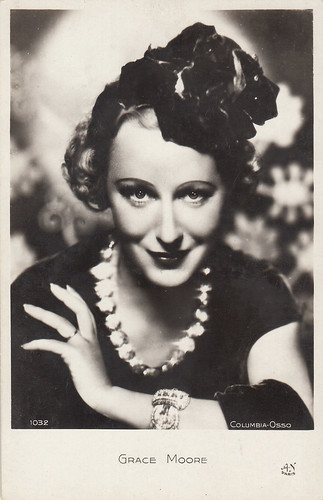
French postcard by A.N., Paris, no. 1032. Photo: Columbia - Osso.

Italian postcard by Vecchioni & Guadagno, Roma. Grace Moore in When You’re in Love (Robert Riskin, Harry Lachman, 1937).
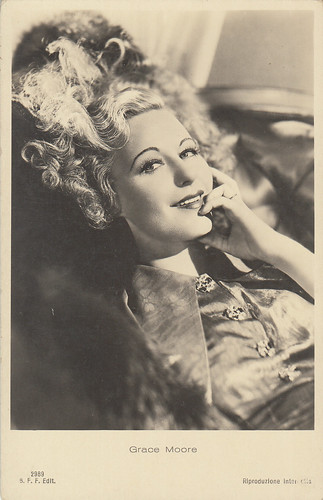
Italian postcard by B.F.F. Edit., no. 2989.
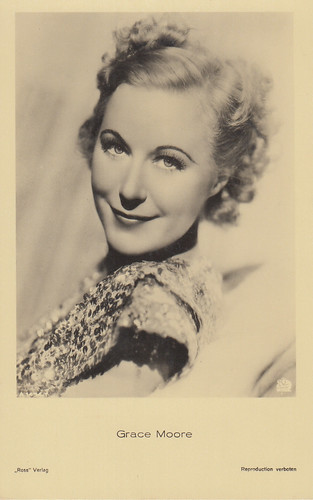
German postcard by Ross Verlag, no. A 1454/1, 1937-1938. Photo: 20th Century Fox.
Last years on stage
After her movie career had ended, Grace Moore appeared in 'Louise' several times at the Metropolitan Opera.
She could be seen there in other operas as well, such as Massenet’s 'Manon' or Puccini’s 'Tosca'.
She also toured in America and Europe and, during World War II, devoted much time and energy to entertain the U.S. Armed Forces.
During a Scandinavian tour, Grace Moore died in a plane crash in Copenhagen on the 26th of January 1946.
In 1953, Kathryn Grayson portrayed her in So This Is Love, a rather fictionalised biopic which depicts Grace Moore’s rise to fame.
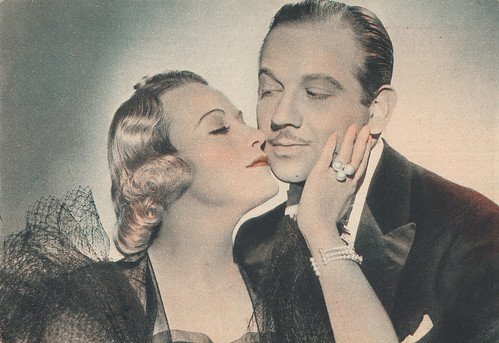
Italian postcard by Vecchioni & Guadagno, Roma. Grace Moore and Melvyn Douglas in I’ll Take Romance (Edward H. Griffith, 1937).
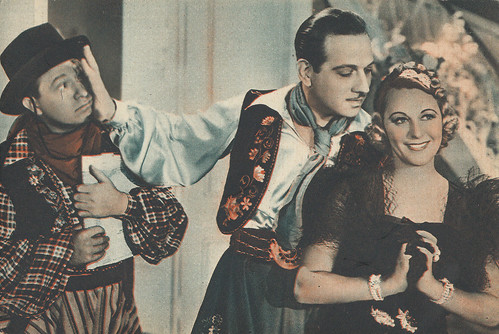
Italian postcard by Vecchioni & Guadagno, Roma. Grace Moore, Melvyn Douglas and Stuart Erwin in I’ll Take Romance (Edward H. Griffith, 1937).
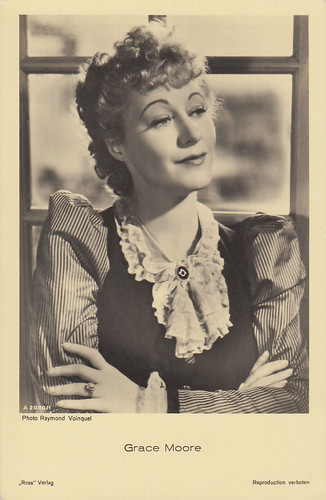
German postcard by Ross Verlag, no. A 2080/1, 1939-1940. Photo: Raymond Voinquel. Grace Moore in Louise (Abel Gance, 1939).
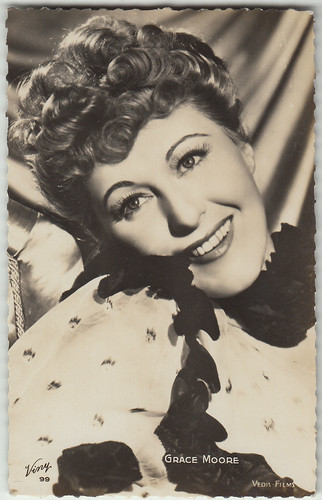
French postcard by Viny, no. 99. Photo: Vedis Films. Grace Moore in Louise (Abel Gance, 1939).
Text and postcards: Marlene Pilaete.
No comments:
Post a Comment